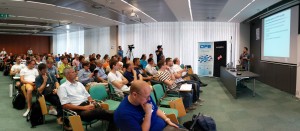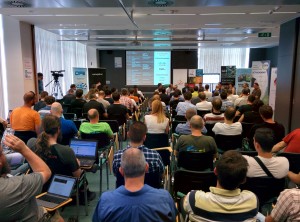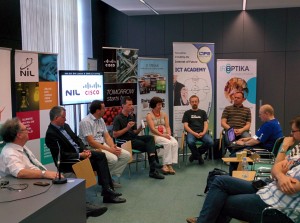The 10th Slovenian IPv6 summit, held on 9 June 2015, attracted around 120 attendees – an impressive number for a country with only 2 million people. Of course, the agenda was packed with good content – Fernando Gont opened the meeting with a keynote on generic IPv6 security and some myths around that and he also closed the meeting with a presentation about his findings and tests around “IPv6 Extension Headers in the wild” and how they are filtered on the Internet.
You can see all the video recordings of the sessions and presentations from the meeting agenda.
After the keynote, our friend Timo Hilbrink from XS4ALL explained their path to IPv6 for all residential customers, lessons learned, issues encountered, and ways to fix them. His presentation set the mood that IPv6 for residential customers can be a reality today and just after his presentation we scheduled a short report from Primož Dražumerič from Telekom Slovenija about their IPv6 test pilot with “friendly residential customers”. To everyone’s enjoyment, the report showed that they had no issues – everything is fine and they already have 600 residential customers on dual-stack and they are completely ready to enable it by default – basically with just one press of the button (or one phone call).
That’s exactly what we wanted to hear after six years of awareness raising, bringing the IPv6 knowledge to the country and persuading operators to deploy IPv6 and enable it for all residential customers.
Well, we have some good operational practice from other countries – Comcast, TWC, Verizon and others in US, Telenet from Belgium, RCS-RDS from Romania, Swisscom in Switzerland and also other rising countries in IPv6 deployment show us that enabling IPv6 by default for all customers is not an issue anymore and there are no reported disasters when it’s happened – in contrary, nobody even noticed.
We were all waiting for the main moment of the day – the panel discussion between CxO level representatives from Slovenian ISPs on why IPv6 is not entirely enabled between content and residential end users. Slovenia is one of the champions of enabling content on IPv6, as we have enabled IPv6 on servers that generate approximately 60% of all http traffic in the country – see vyncke.org stats!
The panel was moderated by our dear friend Davor Šoštarič and consisted of representatives from all the biggest ISPs in the country. The discussion started in a very positive manner, until one of the panelists started explaining that there is no demand for IPv6 from users, there is no business case, and no incentive to switch on IPv6. This remark took all others into the same stream and one of them added that there is no content on IPv6 so there is no incentive to enable it for residential customers.
At that point in time I was completely disappointed with the discussion, my blood pressure reaching dangerous levels. When audience questions opened, I made my remark, noting that I disagree with their several points of view for the following reasons:
- users will never demand IPv6; transition must be as seamless as possible
- IPv6 is a technology update and not a business update
- operators need to offer connectivity to the whole Internet, not just part of it
- if there were 10 different Internet protocols, they would have to support all of them and reach the whole Internet
- there is lots of content on IPv6 – Google, Facebook and other big global players enabled IPv6 and also Slovenian national search engine, TV and other big news portals are accessible on IPv6
- measured fact is that users can reach Facebook 40% faster over IPv6
- big players are removing IPv4 from their internal networks and datacenters (for example Facebook) and translating at the edge
- as operators they should take good care of their customers and develop their networks as the Internet develops…
Why was I so sad?
Operators in my country came a long way in deploying IPv6, some of them spent a lot of money for equipment changes in order to be able to support IPv6 for residential customers, did all the testing of CPE and did the pilot testing with some limited number of their customers – and Telekom Slovenije even enabled the “IPv6” button in its self-service customer portal where people can automatically enable IPv6 on their connection. So they walked many kilometers of this windy and rocky road, but they stopped 1 meter before the finish line – enabling IPv6 for all residential customers – saying that there is no business case, user demand, and content.
I’m completely puzzled. Parse error.
Just the last step, one small step for operators – but giant leap for mankind…
From the reactions from the operators after this panel session I can see that this was a very useful exercise to go through as it was thought provoking – now new ideas started to emerge among operators, going in direction “hey, why exactly shouldn’t we do it?”
Let’s see, time will tell. Hopefully a short one.
The event continued with other very good (as usual) presentations from Ivan Pepelnjak on IPv6 microsegmentation, Nathalie Kunneke Trenaman on her efforts to bring IPv6 into her home and home devices, a Brocade presentation on their switch fabrics and also a presentation from Simon Delakorda on the “impact of not deploying IPv6 on information and civil society”. Thoughtful exploration of this aspect, bridging the technical and civil society communities understanding of each other. The event was continued on the second day with our second SINOG meeting, a young Slovenian Network Operators Group with more broad topics of discussion that are also of interest to operators.
Conclusion: Maybe we managed to move the IPv6 situation in the country a bit further; it’s just one more step and you are done, dear ISPs. Do it, move forward and never again look back.
[NOTE: If you can read Slovenian, Jan has written a similar post (in Slovenian) on the Go6 web site.]



